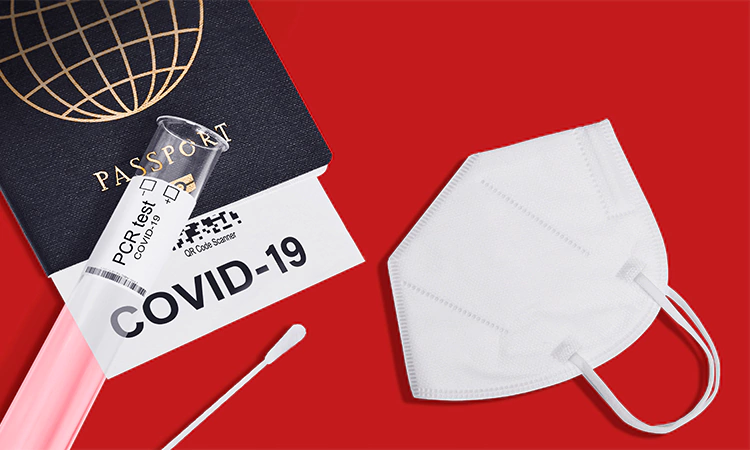If you’re wondering about ‘paano kumuha ng travel pass’, this article is for you! Learn more about the Philippines’ travel restrictions and guidelines, the Safe, Swift, and Smart Passage (S-PaSS), and more.
The COVID-19 pandemic has heavily affected the tourism industry.
With travel restrictions and community lockdowns put in place to control the further spread of the virus, the tourism industry has been put on hold – not just for local travelers and celebrities in the Philippines, but also for international tourists who wish to visit the country’s top tourist spots.
In this article, we answer the question ‘paano kumuha ng travel pass?’, and we also discuss travel guidelines imposed by the national and local government units in relation to COVID-19 to help you with your travel plans.
Quarantine Levels
Effective April 12, 2021, until April 30, 2021, the following places will be placed under Modified Enhanced Community Quarantine (MECQ):
- Abra
- NCR Plus (Bulacan, Cavite, Laguna, Metro Manila, Laguna)
- Quirino Province
- Santiago City, Isabela
The following areas are under General Community Quarantine (GCQ):
- Batangas
- Cagayan
- Isabela
- Lanao del Sur
- Cordillera Administrative Region
- Davao City
- Tacloban City
- Iligan City
- Nueva Vizcaya
- Quezon
The rest of the country will remain under Modified General Community Quarantine (MGCQ).
Quarantine Protocols for MECQ
Minimum public health standards must be complied with at all times:
- Strict home quarantine shall be observed in all households.
- Movement is limited to accessing essential goods and services, and for work in permitted offices and establishments.
- Movement in and out of areas under ECQ/MECQ is allowed only to APORs.
- Recognized IDs are any of the following:
- IATF IDs
- Valid ID/pertinent document issued by allowed establishments
- Local IDs, if required by respective
Is the Philippines Open for Tourism?
Inbound travel or international flights to the Philippines are limited to essential travel only for returning Filipinos, including Overseas Filipino Workers (OFWs), stranded Filipino tourists, and seafarers.
Updates on Travel Restrictions
Here’s the latest update based on the IATF-MEID Resolution No. 112 Series of 2021 dated 27 April 2021.
India Travel Ban
From April 29, 2021, to May 14, 2021, all travelers from India or those with a travel history to India within the last 14 days before arrival, are prohibited from entering the Philippines.
However, all travelers who will arrive in the Philippines before April 29, 2021, may enter the country but are required to complete a 14-day quarantine period in an accredited quarantine facility, regardless of their swab test results.
Entry of Filipinos and Other Foreigners
From March 22, 2021, to April 30, 2021, ALL FILIPINO CITIZENS whether returning Overseas Filipino or Overseas Filipino Workers shall be allowed to return to the Philippines.
The entry of foreigners is also still suspended except for the following:
- Diplomats and members of international organizations, and their dependents, provided they hold a valid 9(e) visa or 47(a)(2) visa, as the case may be, at the time of entry
- Foreign nationals involved in medical repatriation duly endorsed by the Department of Foreign Affairs – Office of the Undersecretary for Migrant Workers Affairs (DFA – OUMWA) and Overseas Workers Welfare Administration (OWWA), provided that they have a valid visa at the time of entry
- Foreign seafarers arriving through seaports under the “Green Lanes” program for a crew change, provided they hold a 9(c) crew list visa at the time of entry
- Foreign parent/s, spouses, and children of Filipino citizens traveling with them provided they have valid visas at the time of entry
- Emergency, humanitarian, and other analogous cases approved by the Chairperson of the NTF COVID-19 or his duly authorized representative provided the foreign nationals have valid visas at the time of entry
For complete information and the latest updates, please refer to the official Bureau of Immigration Facebook Page: https://web.facebook.com/officialbureauofimmigration/.
Paano Kumuha ng Travel Pass?
If you’re planning to visit a place where lockdown restrictions have been eased down, you need to secure and present a travel pass-through permit (TPP) – a document you present to gain entry to places.
To answer the question, ‘paano kumuha ng travel pass?’, the answer is that there are no documents required to obtain the travel pass.
You simply need to go to a police station and talk to law enforcement officials about your need for the TTP.
However, you can now get your Travel Pass through S-PaSS.
The Department of Science and Technology (DOST) developed the Safe, Swift, and Smart Passage or S-PaSS, an innovative travel management system for local travelers who are returning to or visiting different localities in time for the holidays, for vacation, or for business.
The S-PaSS is a travel management system that can facilitate local travel where the public can access information on travel restrictions implemented by different Local Government Units (LGUs) due to the COVID-19 pandemic.
As a travel management system, the S-PaSS will facilitate safe, swift, and smart coordination of travel to the destination LGUs.
Travelers can check the travel restrictions of their destination through https://s-pass.ph.
If your destination has a restricted travel policy, you can apply for a Travel Coordination Permit (TCP) through the S-PaSS.
The TCP has replaced the previously required Travel Authority. However, if your final destination is classified as unrestricted – but you will have to pass through restricted LGUs along the way – you should apply for a Travel Pass-Through Permit (TPP) aside from securing the TCP required by the place of final destination.
Aside from the S-PaSS, the Department of Tourism (DOT) is also considering adopting a COVID-19 digital travel pass as a requirement for travelers to the country once international travel resumes.
“This move is parallel with the steps undertaken by other countries that have successfully relaxed borders to visitors amid the COVID-19 pandemic,” Tourism Secretary Bernadette Puyat said in a statement.
As of April 4, over 20 airlines and airline groups have adopted the IATA Travel Pass on a trial basis.
According to DOT, the IATA Travel Pass has four open-sourced and interoperable modules that can be combined to achieve an end-to-end solution:
- A Travel Pass App that will enable passengers to create a digital passport, verify their tests or vaccinations with regulatory authorities, and submit requirements such as test results or vaccination certificates to facilitate travel;
- A Registry of Health Requirements where passengers can get information on travel, testing, and vaccination requirements;
- A Registry of Testing/Vaccination Centers which enables passengers to find COVID-19 testing centers and laboratories at their departure or arrival locations; and
- A Lab App that will allow authorized COVID-19 testing centers and laboratories to securely send test results or vaccination certificates to passengers.
“Once the country’s adoption of the IATA Travel Pass is put into motion, the DOT hopes to safely reopen our tourist destinations to international visitors and revive the tourism industry as a whole. But this will be done only when the time is right,” Puyat added.
Travel Guidelines – Metro Manila (MNL) Travel Guidelines
| Travel Permission | MECQ: April 12 – 30, 2021 Allowed* ( Extended to May 1- 14, 2021 ) Effective April 30, 2021, ( Extended to May 1- 14, 2021 ) the National Capital Region (NCR) together with the provinces of Bulacan, Cavite, Laguna, and Rizal shall be placed under Modified Enhanced Community Quarantine. Only essential travel into and out of the above-mentioned area shall be allowed. Leisure travels shall be prohibited into and out of during the said period. Only the following authorized persons outside of residences will be allowed to travel (as stated in CAB Advisory): Health and Emergency Frontline Services Personnel Government officials and frontline personnel Duly Authorized Humanitarian Assistance Actors Persons traveling for Medical or Humanitarian Reasons Persons going to the airport for travel abroad Anyone crossing zones for work or business and going back home Returning or Repatriated Overseas Filipinos and Overseas Filipinos returning to their places of residences |
| LSI | Identification Card |
| ROF | Bureau of Quarantine Certificate and Medical Test Result ID as proof of residence |
| APOR | Company ID or Employment Certificate |
| Other Information | For the latest advice, information and resources, go to: https://ncr.dilg.gov.ph/home/riatf-ncr-issuances/ https://www.covid19.gov.ph/ https://www.facebook.com/dilgncr/ |
Per PAL’s Conditions of Carriage, the passenger is solely responsible for verifying and complying with all applicable government laws/regulations of all destinations/countries to be flown from, to, or through.
PAL shall not be liable for the passenger’s failure to comply with said laws/regulations, or for any aid or information given here or by a PAL agent or employee in connection with said laws/regulations.
This page contains the travel rules and requirements for each province, city, or municipality in the Philippines.
Please note that there may be multiple travel requirements for each destination at national and provincial levels.
We would also like to remind passengers that these rules are subject to change by the issuing local government authority and are issued for passengers’ and the public’s safety.
As these requirements may change at short notice, the advisories below are meant only as a guide.
Please make sure that you have the correct and have completed the required documents before you travel.
*CAAP list of airports with LGU Clearance to resume commercial flights. Some airports, while allowing the resumption of commercial flights, are subject to different documentary and passenger LGU restrictions.
The Bottom Line
While traveling throughout the country is available in some areas, it is still highly recommended that you stay at home to prevent the further spread of the COVID-19 virus.
Stay safe and healthy!



